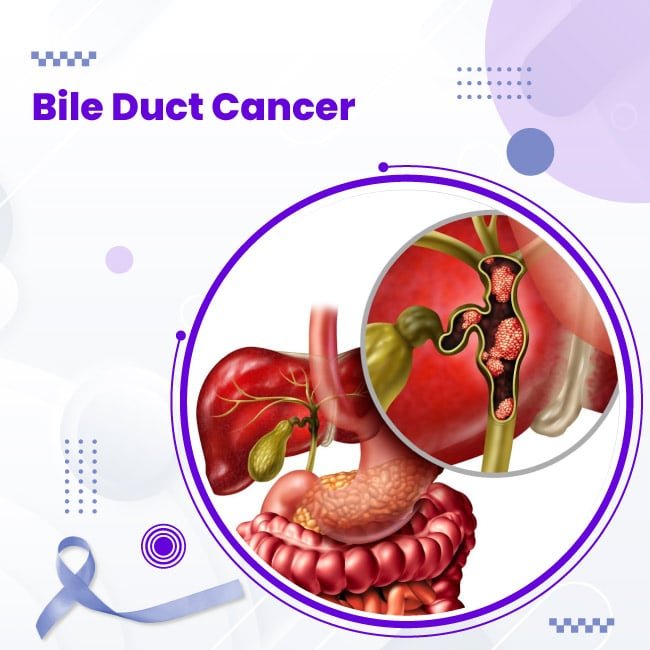
Bile Duct Cancer
Bile duct cancer is a rare form of cancer in which malignant cells grow rapidly. It is also called cholangiocarcinoma. It is a network of ducts that connects the liver, gallbladder, and small intestine.
Types of Bile Duct Cancer
There are three types of Bile Duct Cancer such as –
1. Extrahepatic bile duct cancer – It is a bile duct cancer outside the liver. It is cancer that is located at the exits of the duct or inside the ducts when they end up in the small intestine. There are two types of bile duct cancer –
a. Perihilar bile duct cancer – This type of cancer is found in the area where the right and left duct exit the liver and joins to form the hepatic duct. It is also called a Klatskin tumor or perihilar cholangiocarcinoma.
b. Distal Bile Duct Cancer – It is cancer found in the area where the liver and gall bladder join to form the common bile duct. It passes from the pancreas and ends up in the small intestine. It is also called as Extrahepatic cholangiocarcinoma.
2. Intrahepatic cholangiocarcinoma – It is a bile duct cancer that happens inside the liver. It should not be confused with liver cancer.
3. Gallbladder cancer – It is cancer that starts in the gall bladder.
Bile Duct Cancer
Who is at risk of getting Cholangiocarcinoma?
Persons who are at risk of getting Cholangiocarcinoma are suffering from certain diseases and infections such as –
- Abnormalities where the bile duct and pancreatic duct meet
- Cirrhosis of the liver
- Hepatitis B or Hepatitis C
- Human Immunodeficiency Syndrome (HIV)
- Inflammatory bowel disease
- Non-alcohol fatty liver disease
- Clonorchiasis
- Bile duct stones
Other risk factors include –
- Alcohol
- Diabetes
- Obesity
- Smoking
- Diabetes
- Toxic exposure
Signs and Symptoms
The major signs and symptoms caused by bile duct cancer or other conditions such as –
- Jaundice
- Pain in the abdomen
- Fever
- Nausea and vomiting
- Itchy skin
- Weight loss
- Dark urine
- Clay-colored stool
Bile duct cancer is tested after the above signs and symptoms are witnessed in a patient.
Diagnosis
The tests performed to identify the stage and type of bile duct cancer are as follows –
- Physical Examination – A person’s body health is checked which includes checking for signs of diseases such as lumps or something unusual.
- Lab Tests – These tests use samples of urine, blood, tissue, or other substances to diagnose, check, and monitor the conditions.
- Ultrasound – It uses high-energy sound waves to examine internal organs or tissues such as the abdomen and echoes.
- CT scan – In this procedure, an x-ray machine is used to create detailed pictures of the abdomen area.
- MRI (Magnetic Resonance Imaging) – It uses magnetic waves to make a detailed picture of inside parts of the body.
Treatments
The types of treatment to treat bile duct cancer are –
1. Surgery – Bile duct cancer surgery options range from the location, type, and stage of cancer such as –
- Bile duct removal – To get rid of part of the bile duct if cancer hasn’t spread.
- Partial hepatectomy – To remove part of the bile duct and sections of the liver.
- Whipple procedure – To remove bile duct, gallbladder, part of the pancreas, and small intestine.
- Liver transplant – Replacement of damaged liver with a donor’s liver.
- Palliative surgery – It eases cancer symptoms by removing blockage of the bile duct by placing a small hollow tube in a duct to help it drain into the small intestine.
2. Radiation Therapy – It uses beams of radiation to destroy tumors. It can also be used as a combination therapy for destroying cancer cells in the body. It is usually done after surgery to remove the cancer cells that were left.
3. Chemotherapy – It uses anti-drugs called “chemo” to kill cancer cells. It stops the cancer cells from growing, multiplying, and diving to avoid the further spread of cancer.
4. Targeted Therapy – It targets specific bile duct abnormal genes that have specific proteins that cause the growth of cancer cells in the body.
5. Immunotherapy – It boosts your body’s immune system to fight against cancer cells in the bile duct.
Prevention
It is impossible to prevent Bile duct cancer completely. However, you can take certain precautionary measures to avoid it from happening that includes –
- Getting vaccinated against hepatitis B
- Limit the amount of alcohol consumption
- Maintaining a healthy body weight
- Quit smoking
- Avoiding viruses such as Hepatitis B, C, and HIV
Bile duct cancer is more common in older people. Your risk of getting cholangiocarcinoma increases if you’ve certain conditions or inflammations.
Summary
Uhapo’s medical team of highly-qualified cancer doctors and specialists helps in treating cancer with care. Our treatment is well-focused on aiding patients with necessary diagnostic and therapeutic services. If you’ve concerns regarding your treatments and disorders then you can connect to Uhapo’s contact page – https://www.uhapo.co.in/contact/ or 24/7 Support Number +91-9137-44-1392 for supportive care regarding your necessary issues with cancer.
